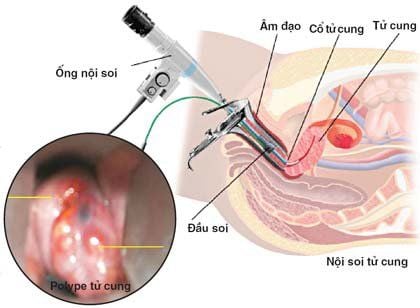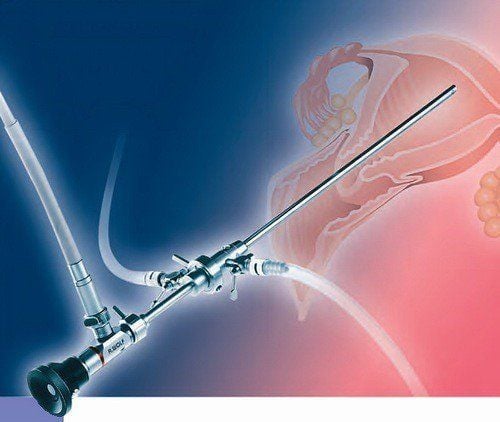This is an automatically translated article.
The article was written by MSc Nguyen Thi Le - Obstetrician and Gynecologist - Department of Obstetrics and Gynecology - Vinmec International General Hospital Da Nang.Hysteroscopy using physiological saline and bipolar cauterization is used in gynecological examination to help diagnose and find the cause of uterine diseases. Hysteroscopy has long also confirmed its position and benefits in the diagnosis and treatment of infertility.
1. What is hysteroscopy? Hysteroscopy is a procedure that uses a laparoscope to look inside a woman's uterus. The endoscope system includes: Probe with camera, the adjustment part containing the adjustment knobs, the wire connecting the machine and the transducer, the display screen.
This is also a minimally invasive but highly effective treatment in cases of uterine polyps, submucosal fibroids.
2. In what cases is hysteroscopy performed? Diagnostic hysteroscopy is usually performed after conducting tests such as ultrasound, X-ray... to help diagnose more accurately the pathologies in the uterine cavity, indicated to:
Find out causes of abnormal bleeding in women through menopause Find out abnormalities in the uterus in infertile women Diagnose the cause of 2 or more consecutive miscarriages in women Diagnostic hysteroscopy Diagnosis is contraindicated in the following cases:
Patient with cervical stenosis Pregnant Contraindication to general anesthesia

3. Features of laparoscopic systems using bipolar ablation In the past, laparoscopic ablation systems using unipolar ablation units required electrolyte-free solutions such as glycine 1.5% or sorbitol ... to stretch the uterus .
However, when using these solutions, there is a risk of excessive fluid absorption leading to electrolyte disturbances, and hyponatremia. In rare cases, pulmonary edema and cerebral edema have been reported, and this condition is common in elderly patients or with right-sided heart failure, renal failure, and liver disease.
Over the past two decades, technological developments have resulted in a number of new instruments that can use bipolar ablation units in hysteroscopy. Advantages of laparoscopic system using bipolar ablation unit compared to monopole are noted:
Use physiological isotonic saline solution (NaCl 0.9%) instead of Glycine solution or Sorbitol, therefore, minimizes the risk of fluid overload Reduces the risk of electrical burns at the site of contact with the electrode plate, reduces the danger for patients with a pacemaker implanted Ability to stop bleeding and better field visualization compared to unipolar ablation unit Reduced operative time Unipolar electrocautery injury is deeper (3-5mm) than bipolar (0.5-1mm), so when using the Bipolar ablation reduces the incidence of uterine adhesions after intervention

4. Steps to conduct hysteroscopy Step 1: The doctor dilates the patient's cervix before performing the procedure. Step 2: Insert the speculum into the vagina first and then insert the endoscope through the cervix into the uterine cavity, physiological saline will be injected through the laparoscope to help dilate the uterus and help the doctor observe The endometrium is more obvious. Step 3: The doctor observes the endometrium and the tip of the fallopian tube through the laparoscope. After the end of endoscopy, if the patient is under general anesthesia, they must be allowed to leave until the anesthetic wears off. You may experience mild cramping or light bleeding for a few days after the procedure. In case of malaria, severe bleeding, you must immediately contact your doctor for a timely treatment plan.
5. Possible complications after hysteroscopy Hysteroscopy is a safe procedure, however, in some cases, the patient may experience a few complications such as:
Allergy to anesthetics, anesthetics. Rubbing damage to the uterine lining. Excessive bleeding. Formation of blood clots, causing blockage. The uterus or cervix may be perforated by the laparoscope, causing heavy bleeding or fluid retention. The patient should walk and exercise gently within 6-12 hours of the procedure. To ensure safety and not cause complications, hysteroscopy should only be performed when there is no pregnancy, no genital infection, and no allergy to substances that stretch the uterus.

Vinmec International General Hospital is one of the hospitals that not only ensures professional quality with a team of leading medical doctors, modern equipment and technology, but also stands out for its examination and consultation services. comprehensive and professional medical consultation and treatment; civilized, polite, safe and sterile medical examination and treatment space. Customers when choosing to perform tests here can be completely assured of the accuracy of test results.
Please dial HOTLINE for more information or register for an appointment HERE. Download MyVinmec app to make appointments faster and to manage your bookings easily.














